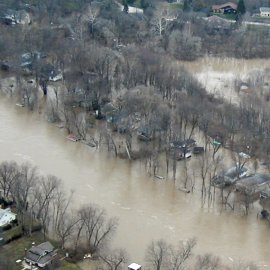Thinking Like a Sponge
-
English
-
ListenPause
[intro music]
Welcome to World Ocean Radio…
I’m Peter Neill, Director of the World Ocean Observatory.
In the south Atlantic, the coincidence of warm ocean water and humid air temperature, wind and evaporation creates weather phenomenon known as tropical cyclones or hurricanes, enhanced over the past decade by changing climate circumstances into intense weather events with erratic paths of high winds and seas that inundate, flood, and flatten coastal communities mostly unprotected and today especially vulnerable as these storms increase in strength, frequency, and consequence. Recently, Hurricane Ida provided an exemplary demonstration of the power of such events, to come ashore at New Orleans, move inland, and then north east, to extend its path of devastation and dislocation, millions left without power, coastal communities inundated, and cost of recovery in the millions.
Ida was a two-headed hydro-event, first as it accelerated in the Gulf of Mexico with its gale force winds and waves, challenging dikes, levees, pumps, and other mitigation protections, and destroying property and people without discrimination. But its second strike was unexpected, and even more destructive, as it passed over New Jersey and New York City without mercy, flooding basements and subway stations for far too many unsuspecting and unprotected. In 2019, Hurricane Sandy had shown New Yorkers what these newly invigorated natural events could do to test protections in the city, after which steps were taken to anticipate and construct additional barriers and systems of protection. Ida proved that this effort was not enough.
These important urban centers, built for accessibility to rivers and ports, conducive for trade and as centers of industry, are no longer safe and secure: fishing facilities and grounds, coastwise manufacturing, industry, and refining, urban and sub-urban communities existing often at or even below sea level are simply not able to withstand the power of these natural events, even more so should frequency and intensity of climate-induced storm and sea level rise continue to amplify as predicted.
What to do? What do these evolving conditions imply for the future? It is going to demand an entirely new level of analysis and planning, construction methods and materials, and innovation to contain, treat, and otherwise manage the hydraulic organization of every community. To not do so, with the evidence provided by Katrina and Ida, is an irresponsible step toward decline.
These problems are not exclusive to the eastern United States, but are part of a worldwide water crisis caused by climate, yes, but also by unsustainable consumption, irrigation, pollution, and all the other challenges to hydraulic society.
Enter the simple sponge, an ubiquitous marine organism, asymmetrical and varied, a living entity adapted for the maximum efficiency of water flow, to absorb, store, and recycle fluid from which nutrition and sustainability are derived. There is wisdom and solution there.
As an example, consider Dagan, a town in Guangzhou Province, China, a city vulnerable to flood disasters from heavy rainfall, offshore tide level, and the continuing effects of typhoons. The city decided to experiment with what was called the “sponge city”, an innovative analysis of the ground conditions, soil absorbability, road and construction patterns, and integrated urban design driven by the necessity to manage water both retroactively (to mitigate existing conditions) and proactively to design or re-design adaptation to projection of future conditions.
Dagan retained the Danish Hydraulic Institute, an international design enterprise that has developed proprietary software to incorporate numerous layers of physical, social, and financial data for a systems’ analysis approach to revolutionary planning. I have discussed their work often as I believe it is the most compelling planning tool for adequate, necessary, creative response to the urban problems that beset us. DHI has used the approach for local solutions as well as massive regional studies and recommendations that transcend historical reality, geopolitical boundaries, and inter-related, integrated socio-economic conditions.
The old methods will not serve. We need to recognize the flow of water - the freshwater ocean continuum - as the primary organizing principle for successful community. We need to adapt through invention; we need to start thinking like a sponge!
We will discuss these issues, and more, in future editions of World Ocean Radio.
[outro music]
Intense weather events are calling attention to not just local but worldwide water crises caused by climate. Coastal inundation, community disruption, dislocation and recovery are problems that we seem increasingly unable to withstand. This week on World Ocean Radio: the Danish Hydraulic Institute and their experiments with the concept of "sponge cities", a revolutionary planning tool to integrate urban design with water management strategies such as ground conditions, road and construction patterns and more, to create responses to rapidly changing coastal conditions.
About World Ocean Radio
Peter Neill, Director of the World Ocean Observatory and host of World Ocean Radio, provides coverage of a broad spectrum of ocean issues from science and education to advocacy and exemplary projects. World Ocean Radio, a project of the World Ocean Observatory, is a weekly series of five-minute audio essays available for syndicated use at no cost by college and community radio stations worldwide.
World Ocean Radio is produced in association with WERU-FM in Blue Hill, Maine and is distributed by the Public Radio Exchange and the Pacifica Network.
Available for podcast download wherever you listen to your favorites.
- Login to post comments



